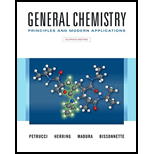
Concept explainers
(a)
Interpretation:
The structure of coordinate complex diaminediaquabromidochloridocobalt(III) ion needs to be determined.
Concept introduction:
The coordinate complex is formed by the reaction of metal ions which are electron deficient with ligands which are electron rich. The structure of the coordinate complex is drawn in such a way that metal ion is always placed at the center. The metal ion is than surrounded by ligands which can be negatively charged or neutral. The shape or geometry of the complex can be determined by number of ligands surrounded by a metal ion.
(b)
Interpretation:
The structure of coordinate complex hexacarbonylmanganese(I) ion needs to be determined.
Concept introduction:
The coordinate complex is formed by the reaction of metal ions which are electron deficient with ligands which are electron rich. The structure of the coordinate complex is drawn in such a way that metal ion is always placed at the center. The metal ion is than surrounded by ligands which can be negatively charged or neutral. The shape or geometry of the complex can be determined by number of ligands surrounded by a metal ion.
(c)
Interpretation:
The structure of coordinate complex diamminetetrachloridoplatinum(IV) needs to be determined.
Concept introduction:
The coordinate complex is formed by the reaction of metal ions which are electron deficient with ligands which are electron rich. The structure of the coordinate complex is drawn in such a way that metal ion is always placed at the center. The metal ion is than surrounded by ligands which can be negatively charged or neutral. The shape or geometry of the complex can be determined by number of ligands surrounded by a metal ion.
(d)
Interpretation:
The structure of coordinate complex diammineaquatrichloridocobalt(II) needs to be determined.
Concept introduction:
The coordinate complex is formed by the reaction of metal ions which are electron deficient with ligands which are electron rich. The structure of the coordinate complex is drawn in such a way that metal ion is always placed at the center. The metal ion is than surrounded by ligands which can be negatively charged or neutral. The shape or geometry of the complex can be determined by number of ligands surrounded by a metal ion.
Want to see the full answer?
Check out a sample textbook solution
Chapter 24 Solutions
Mastering Chemistry With Pearson Etext -- Standalone Access Card -- For General Chemistry: Principles And Modern Applications (11th Edition)
- Give the coordination numbers and write the formulas for each of the following, including all isomers where appropriate: (a) tetrahydroxozincate(ll) ion (tetrahedral). (b) hexacyanopalladate(IV) ion. (c) dichlomaurate(I) ion (note that aurum is Latin for "gold"). (d) diamminedichloroplatinum(Il). (e) potassium diamminetetrachlorochromate(III). (f) hexaamminecobalt(III) hexacyanochromate(III). (g) dibromobis(ethylenediamine) cobalt(III) nitratearrow_forwardExplain in detail π backbonding using the molecular orbitals of CO and a d-transition metal. How does this influence Infrared Spectroscopy and explain how the bond order for the C-O bond changes and how the bond order for the metal-ligand bond changes. Provide pictures and explanations. (Inorganic Chemistry)arrow_forward(a) How would you account for the following: (i) Highest fluoride of Mn is MnF4 whereas the highest oxide is Mn2O2 (ii) Transition metals and their compounds show catalytic properties.arrow_forward
- Are bipyridines (bipy) and analogous amines, phenanthroline (phen) and terpyridine (terpy) chelate ligands?Is there the possibility of the formation of complexes of these ligands with metals in a low oxidation state? Why?arrow_forwardDiscuss and explain the factors that contribute to the preference of a first row transition metal octahedral complex forming a high spin or low spin complex. Explain how you would experimentally determine this. Use examples of octahedral complexes to illustrate your answers.arrow_forwardHow does Ligand Field Theory explain the interaction between the ligand with the central metal leading to increase or decrease of Δo ? Use the concepts of π-donor and π-acceptor ligands.arrow_forward
- please answer the following question: 1. discuss how crystal field theory satisfactorily explains the existence of colour in some coordination complexesarrow_forwardMake a prediction about each structures' splitting energy relative to an octahedral complex with all water ligands. Provide some theoretical basis for these claims (see the protocol for Part 2 and textbook chapter 22 to deepen understanding of these concepts). the structure is K3[Fe(C2O4)3]· 2 H2Oarrow_forwardWhich ligand below gives the LEAST stability to Pd2+ in forming a square planar complexarrow_forward
 Chemistry by OpenStax (2015-05-04)ChemistryISBN:9781938168390Author:Klaus Theopold, Richard H Langley, Paul Flowers, William R. Robinson, Mark BlaserPublisher:OpenStax
Chemistry by OpenStax (2015-05-04)ChemistryISBN:9781938168390Author:Klaus Theopold, Richard H Langley, Paul Flowers, William R. Robinson, Mark BlaserPublisher:OpenStax Principles of Modern ChemistryChemistryISBN:9781305079113Author:David W. Oxtoby, H. Pat Gillis, Laurie J. ButlerPublisher:Cengage Learning
Principles of Modern ChemistryChemistryISBN:9781305079113Author:David W. Oxtoby, H. Pat Gillis, Laurie J. ButlerPublisher:Cengage Learning Chemistry: Principles and ReactionsChemistryISBN:9781305079373Author:William L. Masterton, Cecile N. HurleyPublisher:Cengage Learning
Chemistry: Principles and ReactionsChemistryISBN:9781305079373Author:William L. Masterton, Cecile N. HurleyPublisher:Cengage Learning


